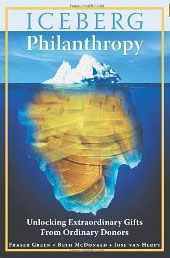
The Loyalty Letter |
| E-news that helps you keep donors connected (and giving) to your cause. |
More |
With four weeks of 2012 under our collective belts, I open with a reminder: have you sent all holiday donation thank-yous? If you haven't, stop reading and start thanking. Your donors are top priority. Still with me? Then let's see why you may have to change your donor care communications this year... ...especially if you want older donors to read what you write. For more, see this month's article below. Whether you're a new subscriber or a longtime friend, thank you for reading. I'm happy you're here. P.S. Last year nonprofit consultant Jim Mueller called our 2010 Kids In Distress Annual Report "one of the best I've seen." How did we follow up this year? Here'slink to 2011. (Designer: S. Collette Design. Copywriter: c'est moi.) |
| Older Donors and Aging Eyes: What Every Fundraiser Must Know |
In the world of fundraising, blog posts about baby boomers abound. But too few address the real boomer bummer: increasingly, they can't read what you write. Here, a look at the problem and how to solve it... In the US, and elsewhere in the world as well, baby boomers are fundraising's latest "low-hanging fruit." Pew Research tells us that on 1 January 2011 we boomers started turning 65 at the eye-popping rate of 10,000+ per day. Even the youngest of us now barrel toward the half-century mark, with each sweep of the second hand. Translation? Prime giving territory. But this isn't exactly a revelation. You don't have to call the US home to hear the crescendo of chants from your donor database, a la Horton Hears a Who!, telling you that:
Your older donors can't read what you write. Or at the very least, they struggle mightily. And increasingly. Which means those same major, loyal, repeat, generous, insert-glowing-adjective-here donors stumble over your eloquently crafted appeals and donor communications... both online AND offline. The villain is presbyopia. Also know as aging eyes, or, "Honey, have you seen my cheaters?" eyes. Here's what's happening... About age 45, according to PubMed Health, the lens of the eye starts to harden and "loses its ability to focus, making it difficult to see objects up close." By 65, it's a done deal. The lens's elasticity is gone, baby, gone. Other changes are happening too. Let's see if you can guess which have seismic implications for your direct mail or Internet fundraising:
So how can you help them, dear fundraiser? Although I don't agree with everything in the articles below, they are the best I've seen on this topic to date. Invest 15 or 20 minutes on these and discover most of what you need to know. Following the list I talk a bit about how my designer colleague Sandie Collette and I recently put the recommendations of these resources into practice:
At least three of the tips in Joanne's article are things you should be doing anyway, not just for older donors, but for ALL donors. For example, Joanne suggests you: use 12 pt type or greater (from Lisa: this depends on how type sets, I've seen appeals in 13 pt, even); use appropriate typefaces (AIGA notes Times Roman, Garamond, Century Schoolbook among most legible); and that you write short paragraphs and use subheadings to break up long blocks of copy. In practice, here's how this works: Recently Sandie and I were called on to write a new donor newsletter for a well-known mental health charity. In selecting the font, we researched those that were proven to be among the most readable, then experimented with varying point sizes by printing sample text at 100% to see how it would read. All long articles had subheads. All photos had captions. We chose matte finish over glossy. Most text was black on white; reversed type (i.e., light text on dark background, typically white on black) was used sparingly. One of Joanne's tips to which we didn't adhere: jumps. We use 'em, because the overarching goal in a donor newsletter - especially on the cover page - is to get people to read deeper. So cover page articles, at least the feature, always continue elsewhere. But the jump line is clearly labeled with part of the headline and the page on which the article began. For an example of how this and some of the other tips work see Merchants Quay Ireland's donor newsletter overhaul here. A final word. In a powerpoint presentation called "Reading, Typography and Low Vision" that I downloaded somewhere on the web - produced by American Printing House for the Blind, but for reasons unknown to humankind is invisible on their site - there is a slide about sans serif vs. serif fonts. Apparently sans serif won for both reading and comprehension in people with low vision. But people with normal vision perceive their performance is better with serif. My advice on this? Before you make the switch from serif to sans serif for print materials, test it. Exhaustively. Decisively. Not in a focus group, not on your board of directors, not by walking it around the office, but in the mail. On real-live donors. See which wins over a couple of mailings, and you'll have your answer, for your audience. For the record, we still adhere to serif for print, sans serif online, with great results |
P.S. Subscribing to The Loyalty Letter is easy: scroll up for handy sign-up form at the top of this page. And lastly, if ever you have a question on donor communications, Email me. |
|
||||||
|
|||
PO Box 814, Wolfeboro, NH 03894
Voice: +001 (860) 881-7009


